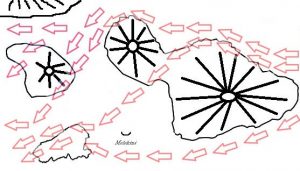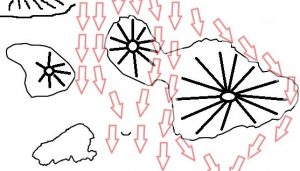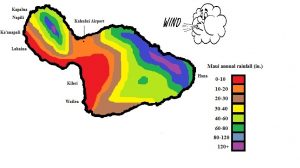The tradewinds, the weather and what this has to do with your stay in our condo!
First of all, we are located in Kahana. Some people call the area Napili. No matter what you call our area, we are located 8 miles north of Lahaina and 3 miles south of Kapalua. When checking weather reports and forecasts this is important!
http://mauinow.com/category/weather/
Of all the weather components in Maui, wind is perhaps the most important—yet least understood—part of Hawaii’s weather. Understanding Hawaii’s wind patterns will explain why it can be windy in Ka’anapali or Kapalua, but completely calm in Lahaina just three miles down the road. To begin with, Maui really only has two types of wind: Tradewinds, and kona winds. So what’s the difference?
With respect to compass points, if the wind is coming from anywhere in the NE quadrant (0°-90°), then this is what’s known as the tradewinds. What direction the tradewinds are blowing from makes a HUGE difference, although we will get into that later. The tradewinds are Maui’s most common wind and blow for about 80% of the year. The summer months of April-October are when the tradewinds are the most consistent, usually blowing somewhere in the 10-30 knot category (12-36mph). The tradewinds can also blow during the winter months, although the pattern is often interrupted by periods of kona winds or days in which there is hardly any wind at all.
The other 20% of the year is categorized by periods of “kona” winds when the winds switch directions and blow out of the south or southwest. Kona winds are often warmer and lighter than tradewinds and usually are only in the 10-15 knot range (12-18 mph). Kona winds are more common during the fall and winter months, and it’s the kona winds which carry the sulfur dioxide known as “vog” up from Kilauea on the Big Island, thereby turning the air hazy for a few days until the tradewinds turn back on.
Ok, so there are tradewinds and kona winds, but what does the direction of the wind have to do with anything?
With respect to the island of Maui, the direction in which the wind is coming from is ultimately more important the overall strength of the wind. Why is this? It’s important to remember that wind is–in its simplest form–air moving from one place to another. All of this air is moving through the Pacific unobstructed for thousands of miles, and then suddenly it encounters all of these tall mountains which need to be navigated. When wind encounters a large mountain, such as Haleakala, it doesn’t just choose to go around one side or the other, but instead, it splits the mountain and passes along both sides of it in the same way that water moves around a rock in the middle of a stream.
Also, when air passes between two large mountains, there is a funneling effect known as a venturi which actually strengthens the wind as it passes through a narrow channel, such as one located between two islands. Consequently, a 20-knot wind out of the north will have a completely different effect on where it’s windy than a 20-knot wind out of the east will, because the air is funneling and moving from a different location.
I’m confused. Explain it to me more. Let’s look at these pictures: This is, for the most part, what an east wind will look like on Maui. Notice the way in which areas such as Molokini and Lahaina are sheltered from the wind, and areas such as Ka’anapali and Kapalua are exposed to the trades. On some occasions, when the east wind is strong enough, it will also weave its way through the valleys of the West Maui mountains at places such as Olowalu.
EAST WIND

When the wind comes out of the north, however, the situation looks a little bit different, despite the wind being the same speed. Notice that in this situation it’s not possible to snorkel at Molokini because the north winds blow directly into the crater. Consequently, most snorkel charters during periods of north winds will instead head to areas such as Olowalu or Launiopoko which lie the slight bit of a lee which might exist.
NORTH WIND

Now that we know the influence the wind direction can have on Maui’s waters, it’s important to remember that in almost all instances the wind doesn’t start blowing until late-morning or early afternoon. If you’re wanting to snorkel, surf, stand up paddle, or just go for a run down the beach, it’s often best to be outside before 10am when the wind will gradually start filling in.
Understanding Windward and Leeward
Now that we understand what dictates Maui’s wind conditions it’s much easier to understand the difference between the island’s windward side and the leeward side. In their simplest terms, windward is the side from which the wind is blowing and leeward is the side which is shielded from the wind. When sailing, if the wind is coming over the port (left) side of the vessel, the port side is known as the windward side and the starboard (right) side is known as the leeward side. As it happens, the same concept applies to islands.

Since Maui’s tradewinds blow out of the northeasterly quadrant for the majority of the year, Maui’s north and east shores are classified as the “windward” side, and the south and west shores are classified as the “leeward” side. To brush up on geography, this places areas such as Hana, Kahului, Makawao, Wailuku, Kapalua, and Napili on the island’s windward side, whereas ares such as Wailea, Kihei, Maalaea, Lahaina, and (barely) Ka’anapali are tucked on the island’s leeward side. For a point of reference, we are on the line where the weather breaks windward/leeward. Which makes this even more confusing!
Since towns on the windward side of the island are closer to the wind, they consequently are going to be windier than those on the leeward side of the island. This much we learned in the last section. Oftentimes, however, moisture in the atmosphere is carried in on the northeasterly tradewinds and therefore makes the windward sides of the island not only windier, but also wetter. This is why areas such as Kapalua receive more rainfall than areas such as Lahaina. In fact, Kapalua actually receives about 30 inches of rainfall per year, whereas Lahaina—which is only nine miles away—receives about 10.
Why such a big difference in such a small area? The answer has to do with something known as “microclimates”.
Understanding Microclimates
Unlike areas on the Mainland which are prone to frontal storm systems which stretch for thousands of miles, Maui’s weather is instead dominated by various microsystems in which the weather can change over the course of less than a mile. Due to the fact that our mountains rise so steeply from the sea the island is heavily impacted by elements of windward , leeward, and the resulting rain shadows. To cite the example from above, the difference between Kapalua and Lahaina is that Kapalua lies on the northern tip of the island, and since it isn’t tucked behind a steep mountainside it’s exposed to the northeasterly wind and rains. Granted, this also accounts for it being much cooler and greener on this part of the island, whereas Lahaina can swelter when Kapalua is cool and comfortable.
If you look at the compass points on a map, Kapalua faces about 340°, thereby placing it in the NW quadrant. Napili/Kahana are at about 300°, Ka’anapali is 270°, and Lahaina is about 210°, thereby placing it in the SW, or leeward quadrant. Similarly, areas such as Kihei and Wailea lie in this dry, SW quadrant, whereas the road to Hana at 45° is right in the middle of the NE quadrant—the wettest of all, which is something that explains all those dense rainforests and towering waterfalls!
One mistake which many visitors to Maui make is that when they check the weather forecast for their upcoming vacation, they will choose a weather site which only displays the forecast for the Kahului Airport on the windier–and wetter–windward side. Consequently the forecast will almost always call for showers. Don’t be discouraged, however, because chances are the weather in resort areas such as Wailea, Kihei, Lahaina, or Ka’anapali, will be experiencing a completely different (often sunnier) forecast than what’s being displayed. For a more accurate weather forecast we recommend reading local weather sites such as Maui Weather Today which breaks down the island’s weather forecast by its various regions.

Although microclimates control the majority of Maui’s weather pattern, they don’t however, dictate the weather 100% of the time. During the winter months Maui can be affected by big cold fronts in the same way that areas on the mainland can, and if a large cold front in the North Pacific (the same storm systems which will eventually drop snow and rain on the west coast of the US) decides to swing south enough, this front can move across the island chain and bring rainy weather to every part of the island. While these fronts oftentimes dissipate over Kauai and Oahu before reaching Maui (and thereby make Kauai and Oahu wetter than Maui), occasionally the front will envelope the entire state and bring up to a week of rain.
This, for us, is winter. We might not get snow (well, Haleakala might), but Hawaii is still prone to winter storms which bring a lot of rain. While no one wants to have a week of rain on their vacation, understand that visiting the islands in winter is a gamble everyone takes. In the same way that a “normal” winter day in your hometown might include sun or it might include snow, a “normal” winter day in Hawaii can be 78° and sunny or it can be 74° and rainy. But at least it’s warm! Since there is nothing you can do to control the weather, winter visitors to Hawaii just need to cross their fingers and hope for the best.
Moral of the story on Maui’s weather: Don’t just look out the window and assume that’s how the weather is on the whole island. Unless Maui is in the throes of a large winter storm, there’s a good chance the weather is different just a few miles down the road. The area between Kahana, Napili and Kapalua are much cooler than Lahaina. And Kihei is typically much warmer than all of these! And then there is Haleakala where it can be 10° and sunny when it’s 80° in Lahania!
So what does all that have to do with you?
We bought our condo knowing that the west Maui tradewinds blow through here VERY reliably. This usually keeps the condo at a nice temperature – 70-74° F most of the time.
There are times when the wind doesn’t blow — it’s rare but does happen. You could be experiencing a Kona Wind or no wind at all. It’s tropical here and a bit different than what you’re probably used to. The temperature averages between 72-82° F during the day and 72-74° F at night. It is pleasant but not stifling humid heat! We have personally experienced very few hot “uncomfortable” days in the five years we’ve been in the area so I don’t want to tell you it can’t happen.
There is no air conditioning (AC) in ANY of the 88 condos in our buildings. It is really not necessary in this area of the island. As a matter of fact, our condo association does not allow air conditioning in any of the units. If having AC is something that you can’t live without, you should not book our condo. The big “mega-resorts” all have AC and many of the other amenities that tourists expect to find. They also cost about twice the price and don’t provide much for your money in an already VERY expensive place. If you understand where you’re going and why the weather is so different here than anywhere else you’ve probably ever been, it will make your stay here a lot more enjoyable!
If you don’t open the windows or doors at our condo, you are going to be VERY uncomfortable!
How to get air flowing through the condo! Since we are not at our condo all the time, it may have been closed/locked up for a significant amount of time. Unfortunately, there won’t be someone there to greet you with a cool drink and read this information to you ☹! It will probably be hot when you first walk in and you’re going to want to fix this issue! Then go get that cool drink 😊!
- When we first get here, we immediately open the bedroom windows and the lanai slider. This gets air flowing through the condo. You will notice the difference almost instantly.
- For optimum airflow, you can leave the front door open and use the screen/security door as the “front door”. Turn on the ceiling fans in the living room and bedroom and it should start to immediately cool down.
- When it is hot, we will crack the front door and lock the security gate at night to keep the air flowing.
We do have two ceiling fans; one in the living room and one in the bedroom. There are also some floor fans in the condo. One thing to keep in mind is that it cools down rather quickly at night and you may find yourself scrambling for blankets and turning off the fans in the middle of the night!
There are some issues related to keeping the lanai sliders open. The birds seem to understand that this is the international signal for “FREE FOOD” and will come in and help themselves to your stuff. There are insects that are attracted to light at night i.e. moths and there are also geckos. None of these things are harmful, just be aware.
We will keep the windows open the entire time we are here and close the place back up when we head to the airport.